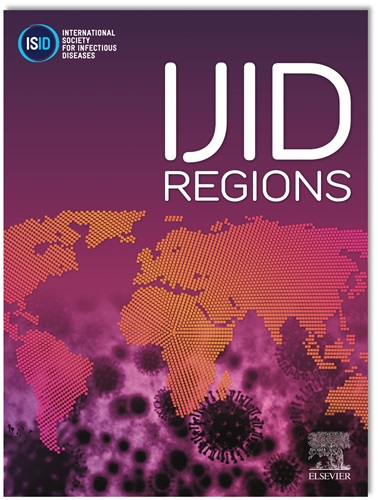Recurrence of microfilaraemia after triple-drug therapy for lymphatic filariasis in Samoa: Recrudescence or reinfection?
IF 4.8
2区 医学
Q1 INFECTIOUS DISEASES
引用次数: 0
Abstract
Objectives
Contrasting evidence is emerging on the long-term effectiveness of triple-drug therapy for elimination of lymphatic filariasis (LF) in the Pacific region. We evaluated the effectiveness of ivermectin, diethylcarbamazine and albendazole (IDA) for sustained clearance of microfilariae (Mf) in Samoa.
Methods
We enrolled two cohorts of Mf-positive participants. Cohort A were Mf-positive participants from 2018, who received directly observed triple-drug therapy in 2019 and were retested and retreated in 2023 and 2024. Cohort B were Mf-positive and treated in 2023 and retested in 2024. Participants were tested for LF antigen and Mf.
Results
In Cohort A, eight of the 14 participants from 2018/2019 were recruited in 2023; six were Mf-positive. In 2024, six participants were retested, and two were Mf-positive. Cohort B included eight participants, and two remained Mf-positive in 2024. Mf prevalence in 2023 for Cohort A (71.4%, 95% CI 29.0%-96.3%) was significantly higher than among their household members (12.0%, 95% CI 2.5%-31.2%).
Conclusion
One or two doses of directly observed IDA was not sufficient for sustained clearance of Wuchereria bancrofti Mf in Samoa. The high Mf prevalence in treated individuals compared to household members suggests recrudescence rather than reinfection.
萨摩亚淋巴丝虫病三联药物治疗后微丝虫病复发:复发还是再感染?
目的:关于太平洋地区消除淋巴丝虫病(LF)的三联药物治疗的长期有效性的对比证据正在出现。我们评估了伊维菌素、乙基卡马嗪和阿苯达唑(IDA)在萨摩亚持续清除微丝虫病(Mf)的有效性。方法:我们招募了两组mf阳性参与者。A队列为2018年开始的mf阳性参与者,2019年接受直接观察三联药物治疗,2023年和2024年进行复检和退组。B组为mf阳性,2023年接受治疗,2024年重新检测。对参与者进行LF抗原和Mf检测。结果:在队列A中,2018/2019年的14名参与者中有8人在2023年被招募;6人呈阳性。2024年,六名参与者重新接受了检测,其中两人呈阳性。B组包括8名参与者,其中2人在2024年仍呈阳性。2023年队列A的Mf患病率(71.4%,95% ci 29.0 ~ 96.3%)显著高于其家庭成员(12.0%,95% ci 2.5 ~ 31.2%)。结论:1 ~ 2剂直接观察到的IDA不足以在萨摩亚持续清除班氏乌chereria Mf。与家庭成员相比,治疗个体的Mf患病率较高,这表明是复发而不是再感染。
本文章由计算机程序翻译,如有差异,请以英文原文为准。
求助全文
约1分钟内获得全文
求助全文
来源期刊
CiteScore
18.90
自引率
2.40%
发文量
1020
审稿时长
30 days
期刊介绍:
International Journal of Infectious Diseases (IJID)
Publisher: International Society for Infectious Diseases
Publication Frequency: Monthly
Type: Peer-reviewed, Open Access
Scope:
Publishes original clinical and laboratory-based research.
Reports clinical trials, reviews, and some case reports.
Focuses on epidemiology, clinical diagnosis, treatment, and control of infectious diseases.
Emphasizes diseases common in under-resourced countries.

 求助内容:
求助内容: 应助结果提醒方式:
应助结果提醒方式:


